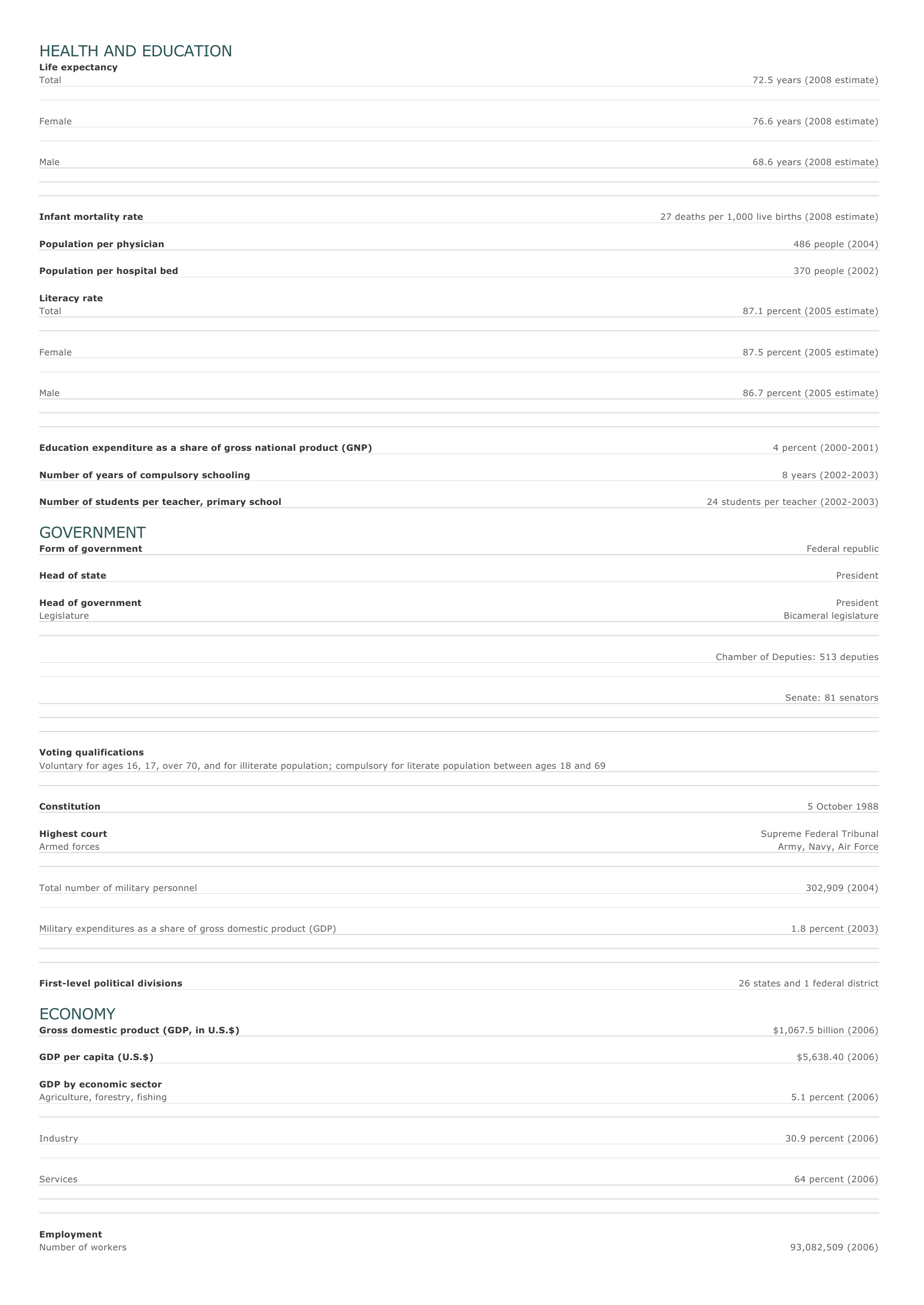Brazil Facts and Figures. BASIC FACTS Official name Capital Area Federative Republic of Brazil Brasília 8,547,404 sq km 3,300,171 sq mi PEOPLE Population 191,908,600 (2008 estimate) Population growth Population growth rate 0.98 percent (2008 estimate) Projected population in 2025 217,825,222 (2025 estimate) Projected population in 2050 228,426,737 (2050 estimate) Population density 23 persons per sq km (2008 estimate) 59 persons per sq mi (2008 estimate) Urban/rural distribution Share urban 84 percent (2005 estimate) Share rural 16 percent (2005 estimate) Largest cities, with population São Paulo 10,886,518 (2007 estimate) Rio de Janeiro 6,093,472 (2007 estimate) Salvador 2,892,625 (2007 estimate) Belo Horizonte 2,412,937 (2007 estimate) Fortaleza 2,431,415 (2007 estimate) Ethnic groups Caucasian (includes Portuguese, German, Italian, Spanish, and Polish) 55 percent Mixed Caucasian and African 38 percent African 6 percent Other (including Japanese and Arab) 1 percent Languages Portuguese (official), Spanish, English, French Religious affiliations Roman Catholic (nominal) 90 percent Spiritists and African Brazilian religions, such as Candombl, Macumba, and Umbanda 4 percent Nonreligious 2 percent O ther 4 percent HEALTH AND EDUCATION Life expectancy Total 72.5 years (2008 estimate) Female 76.6 years (2008 estimate) Male 68.6 years (2008 estimate) Infant mortality rate 27 deaths per 1,000 live births (2008 estimate) Population per physician 486 people (2004) Population per hospital bed 370 people (2002) Literacy rate Total 87.1 percent (2005 estimate) Female 87.5 percent (2005 estimate) Male 86.7 percent (2005 estimate) Education expenditure as a share of gross national product (GNP) Number of years of compulsory schooling Number of students per teacher, primary school 4 percent (2000-2001) 8 years (2002-2003) 24 students per teacher (2002-2003) GOVERNMENT Form of government Head of state Head of government Legislature Federal republic President President Bicameral legislature Chamber of Deputies: 513 deputies Senate: 81 senators Voting qualifications Voluntary for ages 16, 17, over 70, and for illiterate population; compulsory for literate population between ages 18 and 69 Constitution Highest court Armed forces Total number of military personnel Military expenditures as a share of gross domestic product (GDP) First-level political divisions 5 October 1988 Supreme Federal Tribunal Army, Navy, Air Force 302,909 (2004) 1.8 percent (2003) 26 states and 1 federal district ECONOMY Gross domestic product (GDP, in U.S.$) GDP per capita (U.S.$) $1,067.5 billion (2006) $5,638.40 (2006) GDP by economic sector Agriculture, forestry, fishing 5.1 percent (2006) I ndustry 30.9 percent (2006) Services 64 percent (2006) Employment Number of workers 93,082,509 (2006) Workforce share of economic sector Agriculture, forestry, fishing 21 percent (2004) I ndustry 21 percent (2004) Services 58 percent (2004) Unemployment rate 9.7 percent (2003) National budget (U.S.$) Total revenue $206,447 million (1998) Total expenditure $190,891 million (1998) Monetary unit 1 real (R$), consisting of 100 centavos Agriculture Soybeans, coffee, tobacco, sugarcane, cacao beans, beef and poultry Mining Iron ore, tin, gold, oil, phosphates, platinum, bauxite, uranium, manganese, copper, coal Manufacturing Machinery and transportation equipment, food products, textiles and clothing, chemicals Major exports Road vehicles and parts, coffee and coffee substitutes, metals, feeding-stuff for animals Major imports Petroleum, road vehicles and parts, electrical machinery, organic chemicals, industrial machinery and parts Major trade partners for exports United States, Netherlands, Germany, China, Mexico Major trade partners for imports United States, Argentina, Germany, Japan, Italy ENERGY, COMMUNICATIONS, AND TRANSPORTATION Electricity production Electricity from thermal sources Electricity from hydroelectric sources 7.42 percent (2003 estimate) 84.32 percent (2003 estimate) Electricity from nuclear sources 3.73 percent (2003 estimate) Electricity from geothermal, solar, and wind sources 4.52 percent (2003 estimate) Number of radios per 1,000 people 434 (1997) Number of telephones per 1,000 people 230 (2004) Number of televisions per 1,000 people 343 (2000 estimate) Number of Internet hosts per 10,000 people Daily newspaper circulation per 1,000 people Number of motor vehicles per 1,000 people Paved road as a share of total roads SOURCES Basic Facts and People sections 180 (2003) 43 (1998) 170 (2004) 6 percent (2000) Area data are from the statistical bureaus of individual countries. Population, population growth rate, and population projections are from the United States Census Bureau, International Programs Center, International Data Base (IDB) (www.census.gov). Urban and rural population data are from the Food and Agriculture Organization (FAO) of the United Nations (UN), FAOSTAT database (www.fao.org). Largest cities population data and political divisions data are from the statistical bureaus of individual countries. Ethnic divisions and religion data are largely from the latest Central Intelligence Agency (CIA) World Factbook and from various country censuses and reports. Language data are largely from the Ethnologue, Languages of the World, Summer Institute of Linguistics International (www.sil.org). Health and Education section Life expectancy and infant mortality data are from the United States Census Bureau, International Programs Center, International database (IDB) (www.census.gov). Population per physician and population per hospital bed data are from the World Health Organization (WHO) (www.who.int). Education data are from the United Nations Educational, Scientific and Cultural Organization (UNESCO) database (www.unesco.org). Government section Government, independence, legislature, constitution, highest court, and voting qualifications data are largely from various government Web sites, the latest Europa World Yearbook, and the latest Central Intelligence Agency (CIA) World Factbook. The armed forces data is from Military Balance. Economy section Gross domestic product (GDP), GDP per capita, GDP by economic sectors, employment, and national budget data are from the World Bank database (www.worldbank.org). Monetary unit, agriculture, mining, manufacturing, exports, imports, and major trade partner information is from the statistical bureaus of individual countries, latest Europa World Yearbook, and various United Nations and International Monetary Fund (IMF) publications. Energy, Communication, and Transportation section Electricity information is from the Energy Information Administration (EIA) database (www.eia.doe.gov). Radio, telephone, television, and newspaper information is from the United Nations Educational, Scientific and Cultural Organization (UNESCO) database (www.unesco.org). Internet hosts, motor vehicles, and road data are from the World Bank database (www.worldbank.org). Note Figures may not total 100 percent due to rounding. Microsoft ® Encarta ® 2009. © 1993-2008 Microsoft Corporation. All rights reserved.





